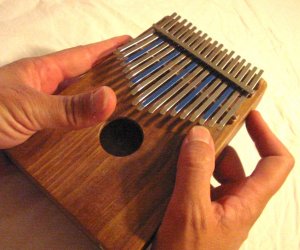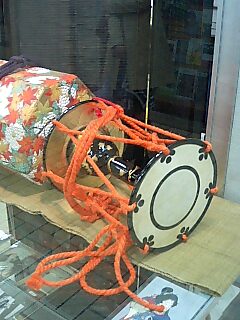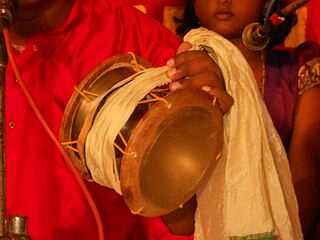
String instruments, stringed instruments, or chordophones are musical instruments that produce sound from vibrating strings when a performer plays or sounds the strings in some manner.
Hornbostel–Sachs or Sachs–Hornbostel is a system of musical instrument classification devised by Erich Moritz von Hornbostel and Curt Sachs, and first published in the Zeitschrift für Ethnologie in 1914. An English translation was published in the Galpin Society Journal in 1961. It is the most widely used system for classifying musical instruments by ethnomusicologists and organologists. The system was updated in 2011 as part of the work of the Musical Instrument Museums Online (MIMO) Project.
A membranophone is any musical instrument which produces sound primarily by way of a vibrating stretched membrane. It is one of the four main divisions of instruments in the original Hornbostel-Sachs scheme of musical instrument classification.

An idiophone is any musical instrument that creates sound primarily by the vibration of the instrument itself, without the use of air flow, strings (chordophones), membranes (membranophones) or electricity (electrophones). It is the first of the four main divisions in the original Hornbostel–Sachs system of musical instrument classification. The early classification of Victor-Charles Mahillon called this group of instruments autophones. The most common are struck idiophones, or concussion idiophones, which are made to vibrate by being struck, either directly with a stick or hand or indirectly, with scraping or shaking motions. Various types of bells fall into both categories. A common plucked idiophone is the Jew's harp.

A drumhead or drum skin is a membrane stretched over one or both of the open ends of a drum. The drumhead is struck with sticks, mallets, or hands, so that it vibrates and the sound resonates through the drum.

The atabaque is a tall, wooden, Afro-Brazilian hand drum, similar to conga.

A lamellophone is a member of the family of musical instruments that makes its sound by a thin vibrating plate called a lamella or tongue, which is fixed at one end and has the other end free. When the musician depresses the free end of a plate with a finger or fingernail, and then allows the finger to slip off, the released plate vibrates. An instrument may have a single tongue or a series of multiple tongues.

The mridangam is a percussion instrument of ancient origin. It is the primary rhythmic accompaniment in a Carnatic music ensemble. In Dhrupad, a modified version, the pakhawaj, is the primary percussion instrument. A related instrument is the Kendang, played in Maritime Southeast Asia. Its a complex instrument to tune and involves a lot of mathematics to construct korvais.

The tsudzumi (鼓) or tsuzumi is a hand drum of Japanese origin. It consists of a wooden body shaped like an hourglass, and it is taut, with two drum heads with cords that can be squeezed or released to increase or decrease the tension of the heads respectively. This mechanism allows the player to raise or lower the pitch of the drum while playing, not unlike the African talking drum and the Indian dhadd.

The idakka, also spelt edaykka/edakka, is an hourglass-shaped drum from Kerala in south India. This handy percussion instrument is very similar to the pan-Indian damaru. While the damaru is played by rattling knotted cords against the resonators, the idakka is played with a stick. Like the damaru, the idakka's pitch may be bent by squeezing the lacing in the middle. The idakka is slung over the left shoulder and the right side of the instrument is gently beaten with a thin curve-ended stick. It is played in temples and in performances such as Kathakali and Mohiniattam classical dance.

A friction drum is a musical instrument found in various forms in Africa, Asia, Europe and South America. In Europe it emerged in the 16th century and was associated with specific religious and ceremonial occasions.

A violin consists of a body or corpus, a neck, a finger board, a bridge, a soundpost, four strings, and various fittings. The fittings are the tuning pegs, tailpiece and tailgut, endpin, possibly one or more fine tuners on the tailpiece, and in the modern style of playing, usually a chinrest, either attached with the cup directly over the tailpiece or to the left of it. There are many variations of chinrests: center-mount types such as Flesch or Guarneri, clamped to the body on both sides of the tailpiece, and side-mount types clamped to the lower bout to the left of the tailpiece.
Struck idiophones is one of the categories of idiophones that are found in the Hornbostel-Sachs system of musical instrument classification.

The putipù is a musical instrument traditionally used in folk music of Southern Italy, in particular of Naples and surrounding regions. It is a friction drum, consisting of a cylindrical sound box closed at the top by a stretched membrane, with a bamboo cane attached at the center. The instrument is played by rubbing the rod with a wet hand, cloth, or sponge, that causes the membrane to vibrate.

The udukkai, udukai or udukku is a member of the family of membranophone percussion instruments of India and Nepal used in folk music and prayers in Tamil Nadu. The drums are an ancient design of hourglass drums similar to the northern damaru and southern idakka. Its shape is similar to other Indian hourglass drums, having a small snare stretched over one side. They are played with the bare hand, and the pitch may be tered by squeezing the lacing in the middle. It is made of wood or brass and is very portable. It originated in Tamil Nadu as well. Other members in the family include thehuruk, hurkî, hurko, hudko or hudka, utukkai.
Directly struck membranophones is one of the sub-categories of musical instruments found in the Hornbostel-Sachs system of musical instrument classification. The type of membranophones or drums found in this group are those instruments that produce sound when struck directly by the performer. The membrane of these drums is hit with a stick, the hand, or something else. Drums that produce sound by means of plucking an attached string or by means of friction are grouped in a different category.

There are several overlapping schemes for the classification of percussion instruments.